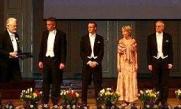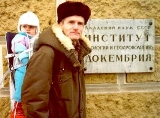In my micropaleontological studies in the 1980’s I dealt with peridinioid dinoflagellates, as a morphologically defined group, from the Upper Cretaceous (Maastrichtian) of Trelleborg at the southwestern part of Scania (Skåne), southern Sweden. My intention was to contribute to the taxonomy of this group by describing the forms present, recording their dimensions, and analysing the relations in shape between endocyst and pericyst.
Fossil dinoflagellates that appear morphologically related to modern Peridinium and Protoperidinium were treated as peridinioid dinoflagellate cysts. Several types, styles, and shape variants of archeopyles were recognized in this group.
In peridiniacean genera as a rule the archeopyle corresponds to the second anterior intercalary paraplate (2a) and the inferred paratabulation is of the hexastyle.
Genera which reveal indications of a quadrastyle paratabulation or have intercalary archeopyles corresponding to more than one paraplate (e.g. Trithyrodinium) or combination archeopyles corresponding to paraplates of different series (e.g. Palaeoperidinium) were not included in the peridiniacean genera, but regarded as peridinioid.
In papers on dinoflagellates detailed recordings of dimensions of the material studied and calculations on those data were rarely presented. Before 1980 I found only three studies that used morphometry:
- Regression analysis was used to study the relation between horns and cyst body
- The distribution of length/width ratio was used to study the interspecific variation and taxonomy of Alterbia
- Dimensions of length, width, and length of horns and spines were graphically presented in one paper
I have treated ten species of acid resistant peridinioid dinoflagellates of Deflandrea, Isabelidinium, Palaeoperidinium, Phelodinium, Subtilisphaera, Svalbardella, and Trithyrodinium from this Upper Cretaceous (Maastrichtian) material from southern Sweden.
Taxonomical conclusions
- The discrimination between Isabelidinium Lentin & Williams (1977) and Eurydinium Stover & Evitt (1978) according to the diagnoses, by means of length/width ratio of the endocyst is not justified in my studies. This ratio displays a normal distribution which includes values which originally have been considered critical for the discrimination of two separate genera.
- The features discriminating Isabelidinium Lentin & Williams (1977) and Chatangiella Vozzhennikova (1967) are not clearly indicated in the original descriptions. Most of the diagnostic differences may be modifications due to environmentally controlled factors. In preserved material those morphologic features seem to display ranges which include both genera. I have published the new combination Isabelidinium armatum (Cookson & Eisenack) Lindgren.
- Lejeunia kozlowskii Górka (1963) is a cornucavate cyst referable to Phelodinium Stover & Evitt and different from Lejeunecysta tricuspis (Wetzel) Artzner & Dörhöfer (1978). I have published the new combination Phelodinium kozlowskii (Górka) Lindgren.
- Palaeocystodinium Alberti (1961) is a later synonym of Svalbardella Manum (1960). So is Cystodiniopsis Vozzhennikova (1963) which name however is illegitimate; the designation of a new type species is contrary to the ICBN.
- Ceratiopsis Vozzhennikova (1967) and Pentagonum Vozzhennikova (1967) as names of dinoflagellate genera are illegitimate and must be rejected, as they are later homonyms of Ceratiopsis De Wildeman (1896) and Pentagonium Schauer (1843), which were validly published for a genus of fungi and an asclepiadacean genus, respectively.
References
- Lindgren, S., 1984.
- Acid resistant peridinioid dinoflagellates from the Maastrichtian of Trelleborg, southern Sweden. (Summary in Russian.) Stockholm Contrib. Geol., 39(6): 145—201. Stockholm. ISSN 0585-3532. ISBN 91-22-00519-6. — Buy at the lowest prices among books in Sweden.
- Lindgren, S., 1985.
- Nomenclatural notes on fossil peridinioid dinoflagellates. Taxon, 34 (4): 670—671. Utrecht. ISSN 0040-0262.
Web Links
Dinoflagellates; by Matthew Olney, University College, London.
Dinoflagellates; by Mona Hoppenrath and Juan F. Saldarriaga, Forschungsinstitut Senckenberg, Germany, and University of British Columbia, Canada
Introduction to the Dinoflagellata; by Graham Williams & Andrew MacRae, Museum of Paleontology, University of California, Berkeley.
Peridinium; by Charles J. O’Kelly, Protist Image Database.
Graham Williams, Dartmouth, 1996
Charles Downie, Sheffield, 1923—1999
Bill Sarjeant, Saskatoon, 1935—2002; also in The Encyclopedia of Saskatchewan.
Lewis Stover, Kerrville, 1925—1993
Tamara Vozzhennikova, Novosibirsk, 1914—2000



 Posted by Svenolov Lindgren
Posted by Svenolov Lindgren 









